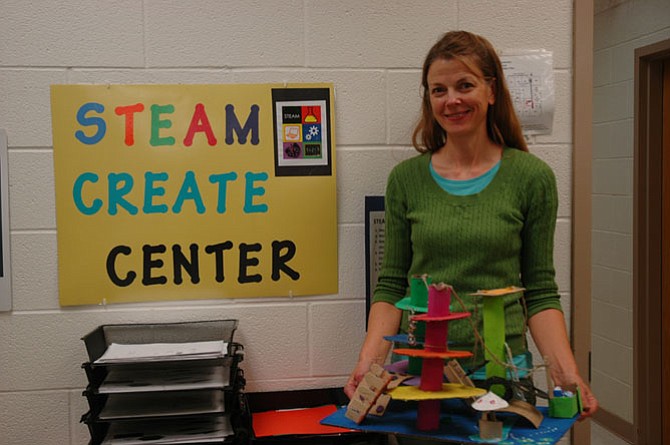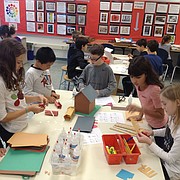Colvin Run art teacher Lauren Grimm’s sixth grade students used STEAM elements to design and build inventive playground sculptures. Photo by Jean Jianos/The Connection
“Learning for Learning’s Sake.” That is the gift that Susan Blackwell, the Science Resource teacher who runs the STEAM Lab at Colvin Run Elementary School (CRES), gives to every student at CRES every week. Blackwell, a former middle school science teacher who has also taught high school level courses, has been responsible for developing and implementing the STEAM Lab curriculum at CRES for the past four years.
Fairfax County Public Schools (FCPS) describes STEAM as student-centered, project-based and interdisciplinary instruction that integrates Science, Technology, Engineering, the Arts, and Mathematics. The entire fourth grade at CRES is involved in one such STEAM Lab project this academic year.
Each fourth grade student has planted a tulip bulb in a Journey North Tulip Test Garden. They are applying the scientific steps of making observations about the tulip bulbs and planting conditions, hypothesizing about when the tulips will emerge based upon data reported from other students across the Northern Hemisphere, and then observing when the tulips emerge and bloom, and reporting their data.
Together with students from Zelenograd, Russia, near Moscow, and everywhere in between, they will track the change in seasons and climate around the globe, and will analyze the data to see how climate, geography and plant growth are related.
“We are going to watch spring happen across the world,” says Blackwell.
WHETHER OUTDOORS in the Tulip Test Garden or within the school building, STEAM learning takes place inside and outside the STEAM Lab. CRES kindergarten classroom teacher Connie Bolz was recently recognized by the National Geographic Education Blog as their Educator of the Week for her S.T.E.A.M. Kids project. Bolz used colored, geometric shapes, or “glyphs,” to introduce the youngest students at CRES to symbols that have become a universal language at the school.
FCPS considers the use and interpretation of symbols in academics and the visual arts in evaluating a student’s application of knowledge. How a student perceives and manipulates patterns, colors and symbols is used by FCPS as an indicator of creative and productive thinking.
Bolz also involved parents in the project. Facilitating relationships with parents by providing students and their parents with such hands-on experiences is one of the objectives of the STEAM Project.
Parents also volunteer in the STEAM Lab and help with hands-on activities. One of the things that Blackwell initiated this year for the Family Science Night, run by the CRES Parent Teacher Organization, is a showcase of family-built, popsicle stick structures. “It’s a family project,” she says, “they are working on it as a family, although I’ve told them that any adults working on it always have to have children supervising them . . . It is not a competition . . . We do a lot of engineering projects and we talk about the engineering design diagram and how you go through that process. I’m excited to see what they come up with.”
Researching, planning and building 3-D models of structures also take place in the art classrooms. The FCPS fine arts program emphasizes critical thinking, innovative problem solving, effective communication and collaboration, as well as teaching students to connect ideas across disciplines. CRES art teacher Lauren Grimm’s sixth grade students worked together to create sculptures of inventive play structures after looking at architectural drawings from around the world and thinking about the needs of the community they wanted to involve, including people with limited mobility or low vision.
Grimm’s fourth grade students, who are studying Colonial America in Social Studies, each selected the kind of colonial structure they wanted to build and then designed the form based upon the function, whether a house, stable or tavern. Grimm observes that children in fourth, fifth and sixth grades often want to socialize and discuss projects, so she can harness that energy by giving her students “an art challenge that they can solve together in a creative way.”
She finds that students are much more engaged and active, from an individual perspective, if they have the freedom to deliberate among choices and to develop original ideas that allow for that personal choice.
Both Grimm and Blackwell give their students permission to have failed outcomes. “They always look at me with surprise at first,” says Grimm, “but then I clarify by telling them that being open to failure allows them to be flexible and explore many creative options.” Blackwell defines success for her students as learning from their mistakes. “I actually emphasize failure a lot in STEAM Lab because so many of the students come in thinking that failure is a bad thing,” says Blackwell. “There is so much trial and error in the STEAM Lab, but I emphasize what did you learn, figure out what went wrong and fix it so you can do it better next time.”
CRES PRINCIPAL Ken Junge credits the fact that throughout all of the grade levels, the art teachers and Ms. Blackwell collaborate so well with the classroom and technology teachers to ensure that students see the connections among the projects on which they are working. “That’s the important part,” says Junge, “that the students understand that there is a connection between what they are doing as hands-on learning in STEAM Lab and what they are doing in art class and the kind of technology they are using down in the computer lab and how all of that encompasses what they are learning in the classroom as part of their general curriculum.”


